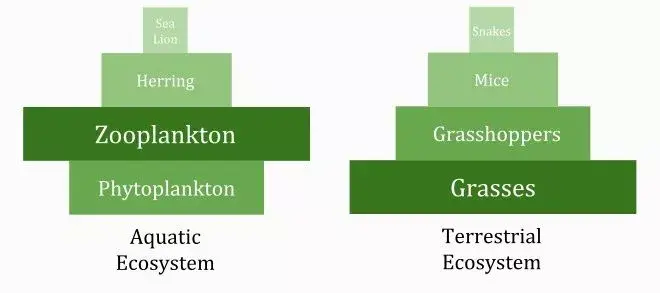Advertisements
Table of Contents
What is Consumer?
Consumer is a category that belongs inside an ecosystem’s food chain. It primarily refers to animals. Consumers cannot generate their own energy and must rely on the intake and digestion of producers, other consumers, or both in order to survive.
- In food chains, consumers are found alongside two additional groups: producers and decomposers.
- All plants are producers because, through photosynthesis, they generate their own energy from sunlight and nutrients. The primary trophic level of the food chain consists of plants.
- Herbivores, or animals that consume solely plants, derive their energy from the flora they devour. Herbivores are characterised as consumers since they cannot generate their own energy. Herbivores are the dominant consumers at the second trophic level since they solely consume producers.
- Omnivores, which ingest both plant and animal matter, are also consumers. The creatures they consume do not generate their own energy and are therefore never considered producers.
- Carnivores, or creatures that consume only meat, occupy diverse positions in various food chains. They could potentially have a predator-prey relationship. Decomposers, which will not be described further in this article, convert the dead matter of producers and consumers into nutrients that producers (plants) then use to grow.
- It is not necessary for food chains to incorporate complete animals. Vegetarians who consume dairy are classified as omnivores, whereas vegans who consume neither dairy nor eggs are equivalent to primary consumers.
- Categorization within a food chain may sometimes be temporary, as is the case with omnivorous calves that become herbivores after weaning.
- Disease, deforestation, the seasons, biodiversity, human encroachment on natural ecosystems, and numerous other variables might influence the position of the consumer within the food chain.
- Additionally, there are numerous species within each group and trophic level. Multiple species can transform a basic food chain into a complicated food web.
- The two simplistic food chains depicted above illustrate the path from producer (dandelion and phytoplankton) to quaternary consumer in terrestrial and marine ecosystems (hawk and shark).
Types of consumer
1. Primary consumers
- Herbivores are the dominant consumers. Their food source is the first trophic level in the food web, which consists of plants.
- Plants are also considered autotrophs. Autotrophs make their own energy from sunlight and basic nutrients through photosynthesis; the phrases producer and autotroph have the same meaning in any environment.
- In addition to leaves, branches, flowers, fruits, and roots of plants, the herbivorous diet also includes autotrophic sources such as nectar and phytoplankton.
- Primary consumers only consume autotrophs. Any organism that must consume food to generate energy is both a heterotroph and a consumer.
- Primary consumers are placed in the second trophic level of the ecosystem, which is quite perplexing.
- The trophic level of an organism is its place in the food chain. As plants are the most fundamental food source, they comprise the first trophic level. Herbivores occupy the next step on the trophic ladder and, as such, are the dominant consumers at the second trophic level.
Examples of Primary consumers
- Primary consumers include zooplankton, butterflies, rabbits, giraffes, pandas, and elephants, among others.
2. Secondary Consumers
- Nearly always consuming both producers and primary consumers, secondary consumers are typically classified as omnivores.
- Secondary consumers comprise the third trophic level of the food chain and are heterotrophs, as are all consumers.
Examples of Secondary Consumers
- Earwigs, ants, badgers, snakes, rats, crabs, hedgehogs, blue whales (whose diet consists mostly of phytoplankton-eating krill and zooplankton, and phytoplankton), lions, and humans are examples of secondary consumers.
3. Tertiary Consumers
- There are both omnivorous and carnivorous tertiary consumers. They devour both main and secondary consumers, and may also consume producers (plants).
- For a food chain to have a tertiary consumer, a secondary consumer must be available for consumption.
- It is noteworthy to note that different creatures in different settings or at different times might occupy comparable trophic levels. For instance, vegans are the predominant consumers of the second trophic level, but the majority of humans are omnivores.
- Another example is beef consumption before and after the passage of bovine spongiform encephalopathy (BSE) legislation, which prohibited the feeding of cattle cows with meat-and-bone meal.
- Prior to the passage of legislation, the consumption of beef by humans would have classified us as tertiary consumers, as omnivorous cows are themselves considered secondary consumers.
- As a result of the association between bovine spongiform encephalopathy (BSE) and meat-based feeds, farms were only allowed to feed their cows plant-based diets. Consequently, humans are currently secondary consumers of beef, as farms are only permitted to generate meat from primary consumers.
Examples of Tertiary Consumers
- Tertiary consumers include hawks, snakes, crocodiles, and certain large cats.
4. Quaternary Consumers
- Apex predators are not necessarily quaternary consumers. An apex predator is at the peak of its food chain and is not preyed upon by any other organism.
- A quaternary consumer is one that preys on a tertiary consumer. To qualify as a quaternary consumer in a food chain or food web, there must be a tertiary consumer available for predation.
- Quaternary consumers occupy the fifth trophic level and are not present in all food chains.
- As one ascends the consumer hierarchy, the amount of energy necessary to sustain it increases. This is depicted in the diagram below, where the size of each tier of the trophic pyramid shows the relative abundance of each species in a healthy food chain.

Examples
- The white shark, polar bear, and alligator are examples of quaternary instances.
References
- https://education.nationalgeographic.org/resource/consumers
- https://study.com/learn/lesson/producers-consumers-overview-examples.html
- https://en.wikipedia.org/wiki/Consumer_(food_chain)
- https://www.biologyonline.com/dictionary/consumer
- https://biologydictionary.net/consumer/
